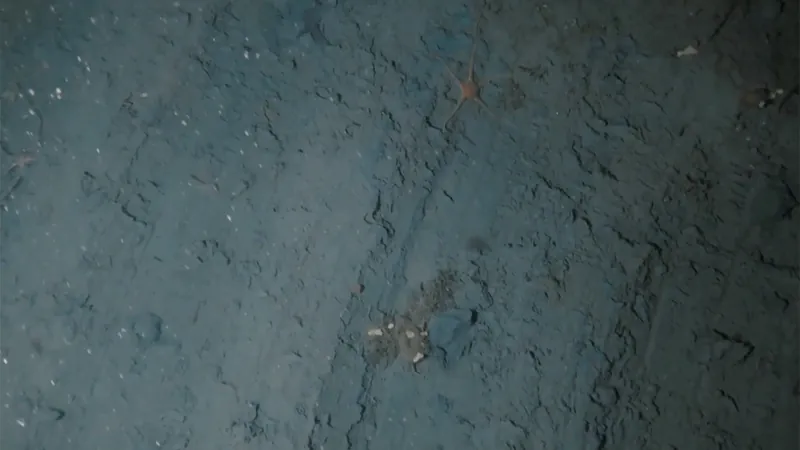
Alarming Discovery: Anchoring Devastates Antarctic Seabed
2025-07-11
Author: Siti
A Shocking Underwater Revelation
Marine scientist Matthew Mulrennan embarked on a journey aboard a tourist vessel, exploring the captivating waters of the Antarctic Peninsula. His underwater cameras unveiled a disturbing sight: a gray seafloor marred by deep scars and ridges, evidence of destructive anchoring practices.
The seafloor, usually vibrant with life, now showed patches of lifeless sediment littered with crushed sponges, perilously close to three ancient giant volcano sponges that can live for up to 15,000 years and dwarf the divers who study them.
"We witnessed a thriving biodiversity on the seafloor but a shocking lack of regulations for its protection," stated Mulrennan, who founded KOLOSSAL, a nonprofit focused on ocean conservation.
A Hidden Ecosystem Under Threat
As Antarctica's sea ice recedes, ship traffic is surging, particularly from tourist cruises eager to showcase the continent's iconic penguins, seals, and whales.
However, beneath the surface lies the true biodiversity hotspot: the seafloor, which hosts 95% of the continent's life. Scientists estimate that up to 17,000 species, many uniquely adapted to Antarctic conditions, inhabit these depths.
These species, including the vital giant volcano sponge, play essential roles in filtering water and sequestering carbon, making their protection crucial as they represent some of the world's most vulnerable ecosystems.
Anchoring: A Slow-Motion Disaster
Mulrennan's survey across 36 sites from 2022 to 2023 revealed significant anchor damage at Yankee Harbour on Greenwich Island. The devastation comes from anchors digging through the sediment as well as the chains dragging along the seabed.
Geophysicist Sally Watson, who co-authored the study, noted that while anchors can penetrate up to 80 centimeters, the real harm stems from the chains that create extensive gouges—damaging critically important life within the uppermost sediment layers.
More Than Just Anchors: Iceberg Impacts
Yet, anchoring isn't the sole culprit wreaking havoc on the Antarctic seabed. Icebergs also contribute significantly, often scouring the shallow seafloor and decimating up to 99% of the life in those areas.
However, Mulrennan's observations, particularly at depths of 70 meters, indicate that the damage at Yankee Harbour can be attributed mostly to anchoring. As marine biologist Lloyd Peck noted, the slow-growing species there demonstrate a resilience that could help repopulate damaged regions.
A Call for Action: Regulating Anchoring Practices
While anchoring may have a relatively minor long-term impact compared to iceberg scouring, the locations where it occurs can disrupt protected areas that icebergs cannot reach.
Both Mulrennan and Watson advocate for stricter regulations governing anchoring, suggesting measures like reduced anchoring times and designated anchor sites to monitor ecological impacts.
As Mulrennan emphasizes, the preservation of these ecosystems is imperative, and there’s an urgent need to recognize anchoring as a significant conservation issue not only in Antarctica but across global waters.
With the increasing urgency of climate change, the call for responsible actions in managing our oceans has never been more critical. It's time to rethink our practices to protect these vital underwater worlds.


 Brasil (PT)
Brasil (PT)
 Canada (EN)
Canada (EN)
 Chile (ES)
Chile (ES)
 Česko (CS)
Česko (CS)
 대한민국 (KO)
대한민국 (KO)
 España (ES)
España (ES)
 France (FR)
France (FR)
 Hong Kong (EN)
Hong Kong (EN)
 Italia (IT)
Italia (IT)
 日本 (JA)
日本 (JA)
 Magyarország (HU)
Magyarország (HU)
 Norge (NO)
Norge (NO)
 Polska (PL)
Polska (PL)
 Schweiz (DE)
Schweiz (DE)
 Singapore (EN)
Singapore (EN)
 Sverige (SV)
Sverige (SV)
 Suomi (FI)
Suomi (FI)
 Türkiye (TR)
Türkiye (TR)
 الإمارات العربية المتحدة (AR)
الإمارات العربية المتحدة (AR)